Below is a detailed article about the primary sources of information about Roman Britain times. There is a lot of information available about Roman Britain that has been studied over the years by archaeological and historical experts. Let us study the various sources below.
Literature
Contents
There is a lot of written matter available from Roman Britain times that is studied in the language that it is available and later made available to all. Roman historians – Lucius Cassius Dio who is also known as Cassius Dio or Dio is mainly responsible for allowing us to understand the conquest of Britain by the Romans. Cassius Dio published over 80 books explaining the Roman conquests in great detail.
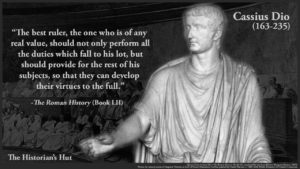
It took him 10 years to gather the information and documents for his writings. He has given a great brief of Roman History until the third century. Many scholars have studied his works and have declared his work to be genuine and reliable. A few scholars think otherwise. His devotion to any theory has narrowed his horizon to give more details only on his interests and theories. Many consider his work vague and impressionist due to this factor.
Dates, numbers and days are found from the literature available in Latin. The poetic works of the poets and writers make it easy to learn of the situation in Roman Britain. It also helps to determine the state of mind of the people. Therefore, literature is one of the primary sources of information about Roman Britain.
Archaeological Excavations
The entire operation of the Roman Imperialism, it’s functioning and effects are gathered and studied due to the archaeological material excavated in Britain. The study of the local life and societies comes from most of the excavations and findings made by the Archaeological department. They are also based on thematic changes and cultural influence that occurred due to the four century-long Roman influence on England.
Even after the fall of the Roman Empire, the province of Britannia Prima flew the flag of Rome until the year 1248 AD, which is nearly 700 years after the Romans left. Edward I captured Caernarfon and finally, the empire fell into the hands of a Barbarian king. Edward I built the castle of Caernarfon as a reminder of the shortcomings of the Roman king Constantine.
The Romans division of Britain into four different provinces provided a map for the study of the aspects of their governance and administration. Archaeological findings indicate the existence of towns like Wroxeter and Chester that were important centers in Roman times.
Many preservations are found in the Roman Britain section of the British Museum. Room 69 of the British Museum contains an array of artifacts that give a look of the daily life of the people in Roman Britain along with Greek influence that is separately shown. Objects on this floor show item such as to illustrate themes such as women, children, home furniture, farming, religion, war and more.

There is another room called The Wolfson Gallery. Items in this gallery show the rise of the Roman empire from a small capital to an empire that controlled the Mediterranean and most of western Europe. The artifacts are from the time Constantine was the Roman emperor and an interesting exhibition shows the journey of the flow of Christianity among the Romans and how it became the official Roman religion. The objects come from all across the Roman empire. They include sculptures of emperors and generals, vases, pottery, glassware and others.
These help in learning the culture, traditions, folklore, life expectancy, any major incidents that occurred and a lot more. They also support the resources of literature available.
Study of evidence
The detailed study of pieces of evidence gathered from the Roman era also hold as a primary source of information about Roman Britain. Many art and history colleges conduct research programs about Roman Britain every year. Intricate research is done and new data are discovered from time to time.
Peter Moore, an archaeologist from the University of Yore found a fragment of glass that appears to be a piece of pottery from the Roman times. It was found in Chedworth Roman Villa in Gloucestershire. It may have been a part of a fish bottle. This has caught the attention of a number of archaeologists that believe that nothing of this sort has been discovered from Roman Britain before. Such data is gathered and heavily researched upon to understand the type of environment the people lived in.
The earliest Roman settlements were found in Yorkshire by a bunch of archaeologists. Here, a hoard of 2000 silver coins was excavated by these archaeologists. According to them, this site may have been a high-class Roman settlement with Roman villas and the families of the governors and high officials may have resided here. The coins date back to the first century during the times of Emperor Vespasian. The burials contained brooches on garments that may have been cloak. This indicated the existence of high-class Roman society in Yorkshire.
Ancient construction from Roman Britain
Hadrian’s Wall
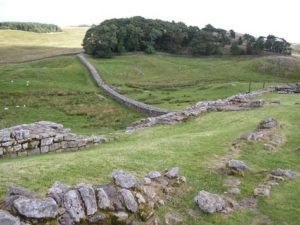
Hadrian’s Wall, also called the Roman Wall extends to 73 miles joining two coasts – the coast of River Tyne to Bowness on Solway. In the Roman era, the wall was built by 15000 men and took 6 years for completion. Even after more than 2000 years today, the wall stands as a solid structure known for its rugged beauty. It is declared a world heritage site in 1987. It is a major tourist attraction today.
Chedworth Roman Villa

The Chedworth Roman Villa is located in Gloucestershire, England. It is one of the largest Roman villas in England. It was excavated in 1864 and then soon put on display. It was located next to a natural spring which was the source of water for the people that lived there. The villa overlooked the River Coln and had a spectacular view. Some Roman mosaics with fine working has been discovered in the Villa.
Antonine Wall
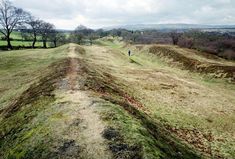
The Romans called it Vallum Antonine. The ruins of the wall are found in Scotland today. It is also a UNESCO World Heritage site. Today, it is called the Central belt of Scotland. The Romans built it to keep away the Caledonians and to gain some Scottish control. It is found in the stretch of the Scottish countryside.
Chester Roman Amphitheatre
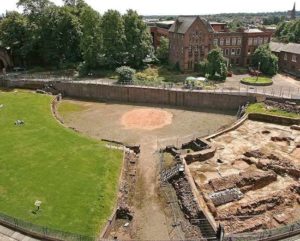
The site is maintained by the English Heritage. It is the largest amphitheater excavated in England. It was built by the King Legio II and then reconstructed by his descendant kings. It is located in Cheshire, England and denotes the importance of the town of Chester as a Roman city.
Housesteads Roman Fort
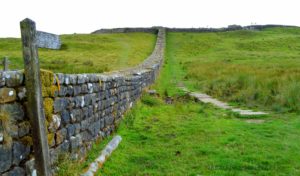
The fort is built on Hadrian’s Wall in an auxiliary manner. The ruins are found in Northumberland, England. The fort was built in 124 AD. It is maintained and owned by the English Heritage. It can be determined from its elevated position that far views of enemies trying to enter could be spotted at the fort.
Historians
Roman Britain Historians like Peter Salway who wrote the book – A History of Roman Britain and others like John Morris and Francis J Haverfield have been highly influential.
